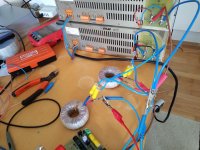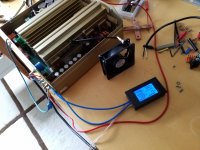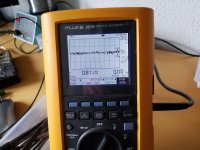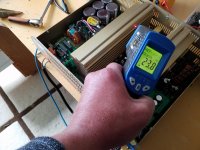I haven't bought from them myself but these guys could be a good alternative for an SMPS: Connexelectronic
Yes, I have a connex PSU on one of my other amps (and several Connex amp modules) and it is going well.
I'm looking at locally sourced ones I can get quickly at the moment though.
I'm thinking of using this SMPS with my JLH 1969. I got a chance to mount it on some proper heatsinks and it sounds really good using the Server supplies I showed in post #16. The server supplies are over-kill and have fans which add a little noise so I would prefer the SMPS if it will work. Is 300W enough for the 69?
Thanks, Terry
Thanks, Terry
I'm always fascinated about SMPS usage for pure class A amps, assuming it is done right (not for skimping purpose, as most SMPS are).
One important note is that SMPS shouldn't run between loaded/unloaded state. On average, it wants a rather constant load. For class A, this isn't much of a problem. For class A/B or Gainclones, tho, it means no good.
For class A/B and Gainclones, you can bleed SMPS output for about twice or three times the bias current, so that SMPS won't go unloaded.
You're correct, but...
You can find the equations for the output inductors, or transformer magnetizing inductance needed for different SMPS modes from vendors like TI, ST or Linear. Linear will walk you through it in their datasheets for their low noise switchers and gate drivers.
If you are going to run an amp in AB with a switcher, you'll just need to design a bigger inductor/transformer.
Don't just slap any old inductor on the output of a switcher -- often the problem is switching noise radiated backwards from the SMPS into the line cord which just acts as a big antenna/radiator (a PEM or "power entry module" is helpful here and there are tons for sale surplus). Wrong size inductor on the output rail of the switcher just raises the impedance with frequency.
Last edited:
I built a Bobo Zen (basically an F5 with no protection circuitry) powered by a pair of Laptop Power Supplies (19v 3.4A each - direct, no power supply caps, each output device at just over 1 amp bias) and sounded great. Traded it for some woodwork, but planning on building another - this time same supplies, but a full blown F5 PCB from DIYAudio. This was my simplest and cheapest amp so far - the four laptop power supplies were $40 shipped from China, and sinks were what I had laying around...
I give all my amps / preamps to a friend for a "review" and he said it was the best amp he heard so far (he hasn't tested my KSA-50 Clone, as it weighs a ton), and he has heard quite a few of my experimental amps (including my Aleph 5, JLH, Elliot Sound P101, and a couple tube amps)....
I will have to try the High Power JLH again with a SMPS...
I give all my amps / preamps to a friend for a "review" and he said it was the best amp he heard so far (he hasn't tested my KSA-50 Clone, as it weighs a ton), and he has heard quite a few of my experimental amps (including my Aleph 5, JLH, Elliot Sound P101, and a couple tube amps)....
I will have to try the High Power JLH again with a SMPS...
My 2 cents
Well... I don't fully understand the hum and noise issue with traditional linear transformer-based PSU.
I give you an example. Simple experinent. Audiolab 8000x7 power amp, in front of it there is a subsonic filter that I have recently mentioned at the other thread. In front of it there is a digital audio processor. All of them are connected with RCA analog cables. No analog volume control - from the processor to the power amp output - full throttle, maximum gain.
Now, you can put your ear against the speaker, even touch the grill with your ear. Nothing. Not even "silence" . Literally nothing. I can't say if the whole system is on or off unless I see it or feed the input signal.
. Literally nothing. I can't say if the whole system is on or off unless I see it or feed the input signal.
What I want to say - if you hear hum, noise or other artefacts, it means either bad design or a bad build. In most cases - second option.
I'm not against SMPS - they are effective, low-pulse, stable (in most cases), though when it comes to critical load - may go off and on (by design), somebody already mentioned this.
The other drawback of SMPS - most of them have got a fan, getting on at higher loads. Well - ok for the stage-type-of equipment, but may be not so good for a living room.
I would use SMPS, "surviving" 8-10 A of peak current, for a 50W amp or so. Maybe a bit more. But for a 150-200W per channel amp I would use a linear one, with appropriate filter (capacitors). Heavy, but holding 15-20 A at the peaks with no hustle, having no option of going off - you can control the rest with the right protection algorythm.
Cheers,
Valery
Well... I don't fully understand the hum and noise issue with traditional linear transformer-based PSU.
I give you an example. Simple experinent. Audiolab 8000x7 power amp, in front of it there is a subsonic filter that I have recently mentioned at the other thread. In front of it there is a digital audio processor. All of them are connected with RCA analog cables. No analog volume control - from the processor to the power amp output - full throttle, maximum gain.
Now, you can put your ear against the speaker, even touch the grill with your ear. Nothing. Not even "silence"
What I want to say - if you hear hum, noise or other artefacts, it means either bad design or a bad build. In most cases - second option.
I'm not against SMPS - they are effective, low-pulse, stable (in most cases), though when it comes to critical load - may go off and on (by design), somebody already mentioned this.
The other drawback of SMPS - most of them have got a fan, getting on at higher loads. Well - ok for the stage-type-of equipment, but may be not so good for a living room.
I would use SMPS, "surviving" 8-10 A of peak current, for a 50W amp or so. Maybe a bit more. But for a 150-200W per channel amp I would use a linear one, with appropriate filter (capacitors). Heavy, but holding 15-20 A at the peaks with no hustle, having no option of going off - you can control the rest with the right protection algorythm.
Cheers,
Valery
Simple.Well... I don't fully understand the hum and noise issue with traditional linear transformer-based PSU.
1. Power supply rejection in the JLH is decent but by no means astronomical. Going by the headphone version, we are talking about a bit over 70 dB input-referred in the relevant frequency ranges. More advanced concepts may reach over 100 dB here.
2. We are talking about a class A amplifier with an idle current of about 1 amp. Substantially higher levels of supply ripple are expected to be encountered compared to an AB amp. JLH himself suggested a supply with active ripple filtering, otherwise the reservoir capacitance would have gotten fairly huge.
A good conventional regulated power supply should work just as well as a SMPS. It obviously is a lot heavier and less efficient though. The downside of SMPS' is that often you don't know what you're getting in terms of construction quality, RFI suppression etc.. When going split supply with 'em, you don't want a model whose ground is tied hard to safety earth either.
Now, you can put your ear against the speaker, even touch the grill with your ear. Nothing. Not even "silence". Literally nothing. I can't say if the whole system is on or off unless I see it or feed the input signal.
What I want to say - if you hear hum, noise or other artefacts, it means either bad design or a bad build. In most cases - second option.
With what sensitivity speakers?
With what sensitivity speakers?
Not really sensitive - Monitor Audio RS series, particularly RS-8 at the front channels. Anyway, power amplifier has got roughly 30db gain, but nothing is audible at the output without signal...
Not really sensitive - Monitor Audio RS series, particularly RS-8 at the front channels. Anyway, power amplifier has got roughly 30db gain, but nothing is audible at the output without signal...
These are 91dB sensitive speakers - so most of the amps I have (even very inexpensive DIY ones like my TDA7297) would be dead quiet as well.
I have amps that are dead quiet with my Econowave speakers (95dB sensitive) that are unlistenable due to the hiss with my HF-144 compression drivers (110dB sensitive) even with 7dB of LPAD attenuation on them to drop them to 103dB sensitive. With these all my amps have some audible hiss near the waveguide, but the best of them are quiet at the listening position....
but back to the JLH 1969 amp.. the first kit I ordered from ebay didnt show up, but the seller refunded me which was good, so I ordered one fro Aliexpress with expedited shipping and a tracking number.
I've assembled it using an old amp chassis I grabbed from the recycling bin, and used a single 30cm large heatsink for both amp modules. It gets hot, but not tooo hot.
Running it at 22VDC, and I measure 10.4DC at the middle point. At the wall it is consuming 70VDC.
Initially it was quite noisy as I'd made some errors in the wiring, but now they are fixed it seems quiet enough, now to integrate it with my active system and have a listen.
Got curious and had to try 2 smps 24v in series, all outputs fully isolated, I tried hooking them up and got some Mv switching noise, i had some old ulveco inductors high current laying and made a Pi filter low pass roughly 1 khz, now i measure with my fluke only 0.25 mv ripple, and some is probably due to poor ground/shielding, it should work perfect when everything is tidied up and in proper chassis.
I would like to have seen it on a scope, but I sold the old one and haven't found its replacement yet, I could hook it up to my soundcard though.
Anyhow, what's your idea of how low ripple should be to power jlh hiraga flawlessly?
Edit. Mentioned mv ripple is measured with 3 amps current draw
I would like to have seen it on a scope, but I sold the old one and haven't found its replacement yet, I could hook it up to my soundcard though.
Anyhow, what's your idea of how low ripple should be to power jlh hiraga flawlessly?
Edit. Mentioned mv ripple is measured with 3 amps current draw
Attachments
Last edited:
I have modded the two smps a bit today, voltage output was difficult to adjust, it has small holes for a hidden multiturn trimmer, I removed them and added a bourns multiturn pot with knob, voltage can now reach from 20v to 27v.
I was a bit frustrated about the forced cooling, very noisy, and permanent, I tried as pictures show to load the one smps with close to realistic class a amplifier load, and fan detached, I used my trusty 8 ohm power load, and let it cook for an hour straight.
Total consumption was 105 watt, and the load took 74 watts, not alot of heat to the smps, after the hour had passed, the left heatsink which was hottest was 5 degrees Celsius above ambient room temperature.
Ripple at that current is quite low, and goes even lower with additional filtering.
I'm not sure I dare running without any fan, but have looked at alternatives for the noisy pabst fan, arctic cooling makes a fitting 92mm fan which has a 20 cm cord with temperature probe attached, at ambient temperature it should run about 500 rpm, and be almost quiet, rpm increases incrementally to temperature, is it worth a try?, or can it simply run fanless ?
I was a bit frustrated about the forced cooling, very noisy, and permanent, I tried as pictures show to load the one smps with close to realistic class a amplifier load, and fan detached, I used my trusty 8 ohm power load, and let it cook for an hour straight.
Total consumption was 105 watt, and the load took 74 watts, not alot of heat to the smps, after the hour had passed, the left heatsink which was hottest was 5 degrees Celsius above ambient room temperature.
Ripple at that current is quite low, and goes even lower with additional filtering.
I'm not sure I dare running without any fan, but have looked at alternatives for the noisy pabst fan, arctic cooling makes a fitting 92mm fan which has a 20 cm cord with temperature probe attached, at ambient temperature it should run about 500 rpm, and be almost quiet, rpm increases incrementally to temperature, is it worth a try?, or can it simply run fanless ?
Attachments
Hi. Isn`t +V +V and -V -V dual outputs ? ThanksA single output SMPS isn't going to power a symmetrical supply amplifier. You'll need two MW modules to do that job.
- Home
- Amplifiers
- Solid State
- SMPS powered JLH 69 - quick and dirty results



